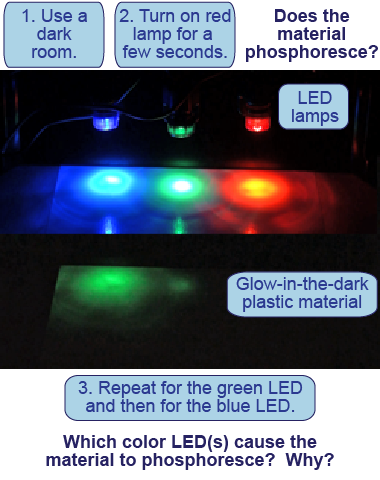|
| Essential questions | | What property of light is required to cause a material to phosphoresce? | |
|
Glow-in-the-dark plastic may seem like a toy, but it has powerful physics embedded into it! The science behind it is called phosphorescence. When you expose a phosphorescent material to light it will glow for a while afterward. Phosphorescence is an accessible demonstration of some of the unusual properties of the physics of the atom. In this short investigation you will explore what kind of light is necessary to make the plastic phosphoresce. Why do some colors make it glow while others do not? Here’s a hint: Think about what physical quantity is different for red versus green or blue light. 
|
Making the material phosphoresce

- For this investigation you will need a dark room, since ambient light may cause the plastic to glow. Pull the window shades and turn off the overhead lights.
- Turn on the red LED lamp and hold it over the plastic material for a few seconds. Then remove the lamp and see if the material phosphoresces—glows in the dark. Record your observations.
- Repeat with the green LED lamp.
- Repeat with the blue LED lamp.
- Which color(s) of light caused the material to phosphoresce?
- What is physically different about this color of light compared to a color that does not cause phosphorescence?
- Explain what property of the light you think is required to cause a material to glow in the dark.
- Try turning on the classroom lights. Then turn them off. Does the material glow? Explain why or why not.
- Do you think that infrared light would cause this material to phosphoresce? Why or why not? Describe an experiment using sunlight and a triangular prism that could test your hypothesis.
- Do you think that ultraviolet light would cause this material to phosphoresce? Why or why not? Describe an experiment that could test your hypothesis. What is the light source for your experiment?
- How is phosphorescence different from
fluorescence? Research the topic to provide justification for your explanation. 
|

